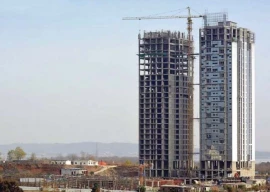
Karachi’s commissioner likens himself to a hockey referee. He is more like a steamroller, however, when it comes to getting the job done. On Thursday, his aim was to get three of the city’s agencies to settle the way water connections are approved for new high-rise buildings.
In Bath Island, for example, builders have been permitted to construct 15 high-rise apartment buildings. This means that the old bungalows where say, 10 people lived will now accommodate up to 100. Ten times the people will need water and flush toilets. But the problem is that the water board says it was never asked if this was feasible.
The builders are getting the green light from the city’s building control authority and Master Plan office but the water board is not signing off on these projects. Technically speaking, the master plan should have already factored in the city’s expansion and need for water connections, but it appears that part of the problem is that changes to the old city areas such as Bath Island are not part of the picture.
A builder explained to The Express Tribune that before they could construct a residential high-rise, they had to get permission from the Karachi Metropolitan Corporation land department (master plan office) and the Sindh Building Control Authority but not the water board. When told that perhaps the rules would change and they would have to also acquire permission from the water board, he said, “All of this is supposed to be part of the Master Plan already. They should have thought about it before. Was the water board asleep then?”

It appears that even if at any point the water board did have to approve new projects, people and the administration stopped following these rules. The repeated changes in the workings of civic agencies and the local government system could be, in part, to blame for the confusion. For example, the water board used to be part of the city government but is autonomous now.
Thus, it took a considerable amount of patient explaining on Commissioner Shoaib Ahmed Siddiqui’s part to get the three agencies - the water board, building control authority, municipal corporation (master plan office) - to agree on one thing: it was not sustainable to keep handing out no-objection certificates for high-rise buildings without checking if there was enough water. Commissioner Siddiqui did not shy from dispensing lessons on democracy, urban planning and civic duty to corner the bureaucrats. They simply could not argue with his logic.
Despite objections from the master plan office on certain technicalities (see below), it was agreed that the water board would take seven days to give permission for a fresh plan for a multi-storey building.
The fine print
In addition to the NoCs, two agencies disagreed on the way to pay for all these new water connections. If, for example, a high-rise apartment building goes up in Bath Island, this will put pressure on the existing pipelines. Perhaps wider ones need to be laid. That means the water board will have to repair or upgrade or lay new pipelines. But how can it pay for this?
It turns out that when a builder goes the building control authority and master plan office for permission to construct a high-rise, he had to pay a 20% betterment charge (also in cantonments). This is meant to help pay for infrastructure. This includes water pipelines and sewers. Technically, as the water board lays pipelines, it argues it should get a part of the betterment charge. The problem is that the money has been going into the KMC kitty.
Then there is the problem of how the 20% should be split on the infrastructure. The officers sitting around the table couldn’t seem to agree on what ‘infrastructure’ meant. They agreed on roads, footpaths, pipelines but then did that mean electricity and gas infrastructure? “Does this mean you’ll give the money to KESC and Sui gas,” asked Misbahuddin Farid, the water board MD.
The water board has been after KMC for a portion of the betterment charge for over two years. What is not clear is why the water board is fighting for this when it already charges builders. “They take Rs4 million from us for new connections,” said a former officer bearer of the Association of Builders and Developers (ABAD). This point did not come up at the meeting.
At the end of two hours with the commissioner, though, it was decided that the secretary of local government would have to come up with a formula to split the 20% between the agencies that deserved it.
Published in The Express Tribune, July 5th, 2013.
1725030039-0/Untitled-design-(2)1725030039-0-405x300.webp)





1614423942-7/-ET-Burns-Road-by-Athar-Khan-(8)1614423942-7-270x192.webp)










COMMENTS
Comments are moderated and generally will be posted if they are on-topic and not abusive.
For more information, please see our Comments FAQ